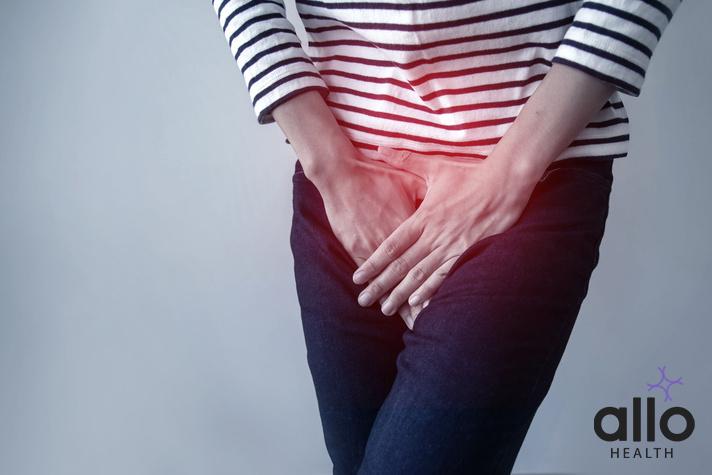Causes Of Vaginal Bleeding After Exercise

Allo Health is dedicated to personalized well-being, offering support and trusted information tailored to individual health goals. The platform emphasizes human-generated content, led by a distinguished medical team of experts, including physicians and sexual health specialists. Their commitment to credibility involves rigorous fact-checking, authoritative research, and continuous updates to ensure accurate, up-to-date information. Allo Health's unique approach goes beyond conventional platforms, providing expert-led insights and a continuous commitment to excellence, with user feedback playing a crucial role in shaping the platform's authoritative voice.

Dr. Aswathi P T earned her MBBS degree and completed her internship at Government Medical College, Kozhikode, and possess diverse professional background spanning 3.5 years. Her experience includes a wide range of healthcare settings, including health centers, hospitals, and teleconsultation services.
Why This Was Upated?
Our experts continually monitor the health and wellness space, and we update our articles when new information became available.
Updated on 26 December, 2023
- Article was updated as part of our commitment to diversity, equity, and inclusion.
"The following blog article provides general information and insights on various topics. However, it is important to note that the information presented is not intended as professional advice in any specific field or area. The content of this blog is for general educational and informational purposes only.
Book consultation
The content should not be interpreted as endorsement, recommendation, or guarantee of any product, service, or information mentioned. Readers are solely responsible for the decisions and actions they take based on the information provided in this blog. It is essential to exercise individual judgment, critical thinking, and personal responsibility when applying or implementing any information or suggestions discussed in the blog."
Are you experiencing vaginal bleeding after exercising? Don’t panic! This is a common issue that many women face. There are various reasons behind vaginal bleeding during or after exercise and our experts impart that knowledge in the easiest way possible. If you are experiencing pain or any emergent situation however, we urge you to visit a clinician or physician as soon as you can.
Exercise and Vaginal Bleeding
Vaginal bleeding during or after exercise can be concerning for some individuals, especially if it is unexpected or excessive.
- Normal Menstrual Cycle: In people with menstruating reproductive systems, a normal menstrual cycle typically lasts about 21 to 35 days, with bleeding lasting for 2 to 7 days. The menstrual cycle is regulated by hormones, and during the cycle, the uterine lining thickens in preparation for a potential pregnancy. If pregnancy does not occur, the uterine lining sheds, resulting in menstrual bleeding.
- Amenorrhea and Exercise: Some female athletes, particularly those who engage in intense physical training or high-level sports, may experience a condition called exercise-induced amenorrhea. This refers to the absence of menstruation for three or more consecutive menstrual cycles. The exact mechanisms behind exercise-induced amenorrhea are not fully understood, but it is believed to involve hormonal imbalances related to stress and energy availability.
- When to Seek Medical Attention: If you experience any of the following, it is advisable to consult a healthcare professional:
- Excessive Bleeding: If bleeding is significantly heavier than a regular menstrual period or continues for an extended period.
- Pain or Discomfort: If you experience severe pain or discomfort along with the bleeding.
- Foul Odor or Discharge: If the bleeding is accompanied by a foul odor or unusual discharge.
- Persistent Irregular Bleeding: If you notice persistent irregular bleeding for several cycles.
- Prevention and Management: To reduce the risk of exercise-induced amenorrhea and irregular bleeding, it’s essential to find a balance between exercise, nutrition, and rest. Adequate calorie intake and proper nutrition are crucial, as extreme caloric deficits can disrupt hormone levels. Consulting a healthcare provider or a sports nutritionist can be beneficial for athletes to ensure they are meeting their nutritional needs.
Every person’s body is different, and individual responses to exercise and hormonal changes can vary. If you have concerns about exercise and vaginal bleeding, it’s best to seek guidance from a healthcare professional who can provide personalized advice and address any underlying concerns.
Different Types of Vaginal Bleeding After Exercise
Vaginal bleeding after exercise can manifest in different forms, and understanding the various types can help individuals identify whether the bleeding is normal or potentially indicative of an underlying issue. Here are the different types of vaginal bleeding after exercise in detail:
- Breakthrough Bleeding or Spotting:
- Breakthrough bleeding or spotting refers to light, intermittent bleeding that occurs between menstrual periods.
- After exercise, hormonal fluctuations can occur, leading to the shedding of a small amount of the uterine lining and causing spotting.
- Breakthrough bleeding is generally considered normal and is often not a cause for concern.
- Mid-Cycle Bleeding:
- Mid-cycle bleeding, also known as intermenstrual bleeding, is bleeding that occurs between periods, around the time of ovulation.
- Exercise can sometimes cause hormonal shifts, which may lead to mid-cycle bleeding in some individuals.
- While occasional mid-cycle bleeding can be normal, persistent or severe bleeding may warrant medical evaluation.
- Heavy Menstrual Flow:
- In some cases, intense exercise can cause an increase in blood flow during the menstrual period, resulting in a heavier flow than usual.
- Heavy menstrual flow after exercise may be more noticeable and may require the use of additional protection, such as a super-absorbent tampon or menstrual pad.
- Prolonged Menstrual Bleeding:
- Prolonged menstrual bleeding refers to periods that last longer than the usual duration of a person’s menstrual cycle (typically 2 to 7 days).
- Exercise-induced hormonal changes can sometimes lead to prolonged menstruation in some individuals.
- Bleeding in Pregnancy:
- In early pregnancy, some women may experience bleeding, which can be mistaken for a light period.
- Intense exercise could potentially trigger this type of bleeding in early pregnancy, but it’s essential to rule out other causes of bleeding in pregnancy and seek medical advice.
- Painful Bleeding:
- Bleeding after exercise may be accompanied by pelvic pain or discomfort in some cases.
- Painful bleeding could be related to conditions such as endometriosis or uterine fibroids.
- Post-Menopausal Bleeding:
- Post-menopausal bleeding refers to vaginal bleeding that occurs after a person has gone through menopause, which is defined as the absence of menstrual periods for 12 consecutive months.
- Any post-menopausal bleeding, including bleeding after exercise, is abnormal and requires immediate medical evaluation to rule out serious conditions such as cervical or uterine cancer.
Causes Of Vaginal Bleeding During Exercise
Vaginal bleeding during exercise can have various causes, and it’s essential to identify the underlying reason to determine whether it’s a normal or concerning occurrence. Here are some of the possible causes of vaginal bleeding during exercise, explained in detail:
- Breakthrough Bleeding:
- Breakthrough bleeding refers to light spotting or bleeding that occurs at unexpected times during the menstrual cycle. It may occur between periods or during early pregnancy for some individuals.
- Hormonal fluctuations can lead to breakthrough bleeding. Intense exercise or physical activity can cause temporary changes in hormone levels, which may trigger this type of bleeding.
- Breakthrough bleeding is generally not a cause for concern unless it becomes persistent or severe.
- Uterine Irritation:
- Vigorous physical activity, particularly high-impact exercises like running or jumping, can cause the uterus to experience increased pressure or friction.
- The uterine lining may become irritated, leading to light bleeding or spotting.
- This type of bleeding is often minimal and typically resolves on its own without medical intervention.
- Hormonal Imbalances:
- Intense exercise or significant changes in physical activity can affect hormone levels in the body.
- Hormones, such as estrogen and progesterone, play a crucial role in regulating the menstrual cycle and maintaining the uterine lining.
- Disruptions in hormonal balance can lead to irregular menstrual cycles, including mid-cycle bleeding during exercise.
- Underlying Medical Conditions:
- In some cases, vaginal bleeding during exercise may be related to underlying medical conditions affecting the reproductive system.
- Conditions such as polycystic ovary syndrome (PCOS), uterine fibroids, endometriosis, or pelvic inflammatory disease (PID) can cause irregular bleeding patterns, and exercise might exacerbate the symptoms.
- If you experience persistent irregular bleeding or have other symptoms like pelvic pain or abnormal discharge, it’s essential to seek medical evaluation.
- Infections or Injuries:
- In rare instances, vaginal bleeding during exercise could be a result of infections or injuries to the genital area.
- Infections like yeast infections or sexually transmitted infections may cause inflammation and bleeding.
- Injuries to the vaginal or pelvic area due to trauma can also lead to bleeding.
What Is Normal Vaginal Bleeding During Exercise?

Normal vaginal bleeding during exercise is typically characterized by light spotting or a slight increase in menstrual flow that occurs during or immediately after physical activity. It is usually considered a normal variation of the menstrual cycle and is not a cause for significant concern. Here are some key points about normal vaginal bleeding during exercise:
- Timing and Occurrence:
- Normal vaginal bleeding during exercise may occur during any phase of the menstrual cycle, but it is most commonly observed around the time of ovulation or during the mid-cycle.
- It is essential to distinguish between spotting and actual menstruation. Spotting refers to light bleeding or small amounts of blood, while menstruation involves a more consistent flow.
- Amount of Bleeding:
- Normal vaginal bleeding during exercise is generally very light and may only require the use of a panty liner or thin pad.
- The bleeding should not be heavy enough to soak through a regular pad or tampon within a short period.
- Duration:
- The duration of normal vaginal bleeding during exercise is typically short-lived. It may last for a few hours to a day, and it usually resolves on its own without medical intervention.
- Associated Symptoms:
- In most cases, normal bleeding during exercise is not accompanied by significant pain or discomfort. Mild cramping may be present, but it is usually not severe.
- Hormonal Influences:
- Hormonal fluctuations, particularly changes in estrogen and progesterone levels, can contribute to normal vaginal bleeding during exercise.
- Exercise can temporarily affect hormone levels, leading to variations in menstrual flow.
- Age and Life Stage:
- The occurrence of normal vaginal bleeding during exercise may vary based on age and life stage.
- Teenagers and young adults may experience more fluctuations in their menstrual cycles due to hormonal changes and irregular ovulation, which can be influenced by exercise.
- Older individuals approaching menopause may also experience changes in their menstrual patterns, and exercise may play a role in these variations.
While normal vaginal bleeding during exercise is generally harmless, it is essential to differentiate it from abnormal bleeding or other concerning symptoms. If you experience any of the following, it’s advisable to seek medical attention:
- Heavy bleeding that saturates a pad or tampon within a short period.
- Severe pain or discomfort associated with the bleeding.
- Prolonged or persistent irregular bleeding.
- Bleeding with a foul odor or accompanied by abnormal discharge.
Medical Conditions That Can Cause Vaginal Bleeding During Exercise
Vaginal bleeding during exercise can be caused by various medical conditions affecting the reproductive system. Here are some of the medical conditions in detail that can potentially lead to vaginal bleeding during or after physical activity:
- Polycystic Ovary Syndrome (PCOS):
- PCOS is a hormonal disorder that affects the ovaries, leading to the formation of multiple small cysts.
- Women with PCOS may experience irregular menstrual cycles, including prolonged or absent periods.
- Hormonal imbalances associated with PCOS can cause breakthrough bleeding or spotting, which may be triggered or exacerbated by intense exercise.
- Uterine Fibroids:
- Uterine fibroids are non-cancerous growths that develop in or on the uterus.
- Depending on their location and size, fibroids can cause abnormal bleeding, including heavy or prolonged menstrual periods.
- Exercise-induced uterine irritation could potentially lead to bleeding in individuals with fibroids.
- Endometriosis:
- Endometriosis is a condition in which the tissue that normally lines the inside of the uterus (endometrium) grows outside the uterus.
- During the menstrual cycle, these endometrial tissues can shed and cause internal bleeding.
- Intense physical activity may exacerbate the pain and bleeding associated with endometriosis.
- Pelvic Inflammatory Disease (PID):
- PID is an infection of the female reproductive organs, typically caused by sexually transmitted bacteria.
- PID can lead to inflammation, scarring, and damage to the fallopian tubes, ovaries, and uterus.
- In some cases, PID may cause irregular bleeding or bleeding during exercise.
- Cervical or Vaginal Infections:
- Infections of the cervix or vagina, such as yeast infections or bacterial vaginosis, can cause inflammation and irritation of the vaginal tissues.
- This irritation may result in bleeding, especially during or after exercise.
- Cervical Polyps:
- Cervical polyps are small, benign growths that can develop on the cervix.
- While they are usually harmless, they may cause bleeding, particularly after sexual intercourse or physical activities like exercise.
- Cervical or Uterine Cancer:
- In rare cases, vaginal bleeding during exercise could be a symptom of cervical or uterine cancer.
- Abnormal bleeding, especially in post-menopausal women or women with risk factors, should be evaluated by a healthcare professional.
Frequently Asked Questions
(1) Is it normal to have mid-cycle bleeding after exercise?
Mid-cycle bleeding, also known as intermenstrual bleeding, can be normal in some instances. It may occur around the time of ovulation and is often associated with hormonal fluctuations. If the bleeding is light and occurs only occasionally, it is generally not a cause for concern. Persistent or heavy mid-cycle bleeding may warrant medical evaluation to rule out any underlying concerns.
(2) Can exercise cause heavy menstrual flow?
Yes, intense exercise can sometimes lead to an increase in blood flow during the menstrual period, resulting in heavier bleeding than usual. The hormonal changes triggered by exercise may impact the uterine lining, leading to a more significant shedding during menstruation. If you experience exceptionally heavy menstrual flow after exercise, consider using super-absorbent menstrual products and consult a healthcare professional if the bleeding becomes concerning.
(3) Should I be worried if I experience post-menopausal bleeding after exercise?
Yes, post-menopausal bleeding is a cause for concern and requires immediate medical attention. Post-menopausal bleeding refers to vaginal bleeding that occurs after a person has gone through menopause, which is the absence of menstrual periods for 12 consecutive months. Any bleeding after menopause, including bleeding after exercise, could indicate serious conditions like cervical cancer or uterine cancer, and should be evaluated promptly by a healthcare provider.
(4) What should I do if I experience vaginal bleeding after exercise?
If you experience vaginal bleeding after exercise, first, don’t panic. Evaluate the amount and duration of the bleeding. If it’s light spotting or breakthrough bleeding and resolves on its own within a day, it’s likely not a cause for concern. If the bleeding is heavy, prolonged, or accompanied by pain, foul odor, or abnormal discharge, seek medical attention promptly. A healthcare professional can perform a thorough evaluation to determine the cause of the bleeding and recommend appropriate management based on your individual health needs. It’s essential not to ignore abnormal bleeding, as it could be a sign of an underlying medical condition that requires attention and treatment.
(5) Can exercise-induced amenorrhea cause vaginal bleeding?
Exercise-induced amenorrhea refers to the absence of menstruation for three or more consecutive menstrual cycles due to intense physical training or high-level sports. While exercise-induced amenorrhea itself does not cause vaginal bleeding, some women may experience breakthrough bleeding or irregular bleeding as a result of hormonal imbalances associated with this condition. If you think you have exercise-induced amenorrhea and experience vaginal bleeding, it’s essential to consult a healthcare professional to determine the underlying cause and address any potential concerns.
(6) Is it normal to have painful bleeding after exercise?
Painful bleeding after exercise is not typical and may be a sign of an underlying issue. Conditions like endometriosis, uterine fibroids, or pelvic inflammatory disease (PID) can cause painful bleeding. If you experience pain along with vaginal bleeding after exercise, it’s crucial to seek medical evaluation to identify the cause and receive appropriate management.
(7) Can infections or injuries lead to vaginal bleeding during exercise?
Yes, infections or injuries in the vaginal or pelvic area can lead to vaginal bleeding during or after exercise. Infections like yeast infections or sexually transmitted infections can cause inflammation and irritation of the vaginal tissues, leading to bleeding. Additionally, injuries or trauma to the genital area may result in bleeding. If you suspect an infection or injury as the cause of the bleeding, seek medical attention for proper diagnosis and treatment.
(8) Can intense exercise affect hormonal balance and cause irregular bleeding?
Yes, intense exercise can impact hormone levels in the body, leading to irregular menstrual cycles and bleeding. Prolonged and intense physical activity can disrupt the delicate balance of hormones, such as estrogen and progesterone, which play a crucial role in regulating the menstrual cycle. Hormonal imbalances can result in irregular bleeding patterns, including bleeding during or after exercise.
(9) Can birth control methods affect vaginal bleeding after exercise?
Yes, certain birth control methods, such as hormonal contraceptives (pills, patches, or injections), can influence menstrual bleeding patterns, including bleeding after exercise. Some women may experience breakthrough bleeding or spotting while using hormonal contraceptives, especially during the initial months of use or if they miss doses. If you have concerns about the impact of your birth control on vaginal bleeding, consult your healthcare provider for guidance and adjustments to your contraceptive regimen if necessary.






































